This is a review of a Nintendo DS game. We don’t review DS games on here, except here we sort of are doing that, obviously. But it’s not going in the main list of PC reviews. As discussed previously, I sort of just wanted to write about this game and get it out of my system.
The first CSI game to be released on the Nintendo DS was a port of 369 Interactive’s Dark Motives. To be honest, it wasn’t great: the source material was pretty bad to begin with, so a technically-compromised version of an already rather stiff and uninspiring adventure was never likely to be a success. There was potential in the format: the DS interface made for easy adventuring on the go, the touchscreen and stylus a ready replacement for the desktop PC’s mouse pointer, but it needed, you know, a little more thought than simply trying to cram an existing CD-based game onto a tiny cartridge.
A better approach, then, was to develop games specifically for the system: while many PSP games fell into the (admittedly tempting) trap of almost-but-not-quite recreating the PS2 experience on handheld, the DS wasn’t powerful enough for developers to have to confront that dilemma on a regular basis. Games that focused on what the machine could do best, both from an audio-visual perspective and in the use of the touchscreen, had the best chance of being successful.
CSI: Deadly Intent – The Hidden Cases is a great example of this. Not only is it an improvement on the DS version of Dark Motives, it’s better than the PC version of Dark Motives or any of the other CSI games. It’s also – wait for it – the best looking and best sounding of all the CSI games, which is some achievement given the limited technical resources of the system on which it was released.
I cannot emphasise enough just how much I love the graphics and sound in this game. Well, I love them enough to Google a few instructions on how to use VirtualDub just so I could share a few video clips with you. The visuals take kind of a graphic novel approach to CSI, while the sound has a 90s tracker music vibe that creates and maintains just the right atmosphere. The best bits hit you almost straight away, in the form of the case setups – borrowed straight from the TV show – in which you witness the initial murder or discovery of the victim:
I could never work out why the PC games didn’t take the same approach, as it’s such a simple way of echoing the show right at the very start, without having to worry about not being able to afford the rights to Who Are You? Certainly, that’s not missed here – the pacing of the opening scenes is just right, and from there, you’re straight into the crime scene itself.
What hits you immediately is that the show’s characters appear as an interpretation of those characters, rather than an attempt to recreate the look of the actors that play them. That might sound like a long-winded way of saying they don’t look quite right, but I personally see it as a deliberate choice to create cartoon versions of the CSIs from the show rather than a failure to create realistic likenesses. Even with the resources to use the faces and voices of the real-life cast, they haven’t necessarily been the greatest asset of the bigger-budget PC and console tie-ins.
Scenes themselves are very easy to navigate. Touching the screen with the stylus creates a target, which then lights up whenever you’re near something that requires further investigation. Releasing the stylus gives you a choice of three options for collection, and it’s simply a matter of choosing the tool that makes the most sense. It’s not particularly challenging, but (as with other CSI games) there are occasional tricks – you see some gauze with some blood on, for example, and try to pick it up, and then the game says you need to swab the blood, not pick up the gauze. All the while, the music creates an atmosphere of mild tension and urgency.
Selecting a method of collection will sometimes prompt a mini-game, in which you use the touch screen to perform a fairly simple task, with varying degrees of care required. Spraying luminol or dusting for prints is straightforward – in a nice touch, the latter involves blowing away dust using the microphone, although of course you don’t have to do so if you’re in a public place, and simply tapping your finger on the microphone slot will do just fine (remarkably, I did read a review that criticised the game for mandatory microphone use, which is a little bit like saying Phoenix Wright obliges you to shout OBJECTION! out loud on the train, and equally untrue).
Things move along at a good pace, with the game sensibly not contriving an additional level of challenge by making things particularly hard to spot. You’re not forced to do a mini-game for each and every bit of evidence you snag, either, which keeps things flowing and prevents the games themselves from becoming too repetitive. Once the scene’s been cleared, a little tick appears over the phone in the corner of your screen to indicate that you’ve found everything that you’re going to.
Then it’s back to the lab for more of the same. The setup is similar to other CSI games: you process evidence in the lab, examine the body in the morgue, and go to Jim Brass’s office to start an interrogation. Here, though, it’s all been streamlined in a way that makes it very obvious what you’re supposed to do next. In particular, awkward interrogations, a feature of the PC games, are avoided here – you don’t interrogate anyone, or even have any kind of meaningful conversation with Brass until the time is right.
The lab and the morgue are a mixture of tapping through conversations and performing mini-game tasks, some of which are repeats of those at the scene, while others are of a more science-y nature and slightly more complicated. Again, you’re not required to process every single piece of evidence, and unlike in the Telltale games, one of the lab technicians, Hodges, makes frequent appearances, processing some evidence and offering advice at various points (the others – Wendy, Henry, Archie – are mentioned, but don’t actually make an appearance). Time in the lab is made more enjoyable by the music that loops in the background, which I enjoy to an almost unnatural extent, while the lab work itself stays on the right side of frustrating.
Did I mention the music in the lab was really good (yes, literally one sentence ago – FFG reader). Well, here it is:
The inclusion of Hodges as a character is just one way in which The Hidden Cases creates a greater feeling of working on a case as part of a team. The lack of voice acting also means that, for once, your player actually has a voice, instead of being some kind of mute rookie. So you have quite a lot of back and forth with other characters, and it feels a lot more like you’re actually participating in the case yourself. (Plus there is of course always comedy value in giving your character a silly name).
As we mentioned, interrogations happen only when they’re meant to happen. In that respect, The Hidden Cases is very linear: you clear the scene, you examine the body, you process the evidence, then your partner will say, “We should talk to this suspect next, go see Brass”, and then you go and do as you’re told. As a result, unlike in the PC games, there’s a nice urgency and tension in the interrogation scenes, because you feel like this is your one shot at this particular suspect. (As it turns out, it’s pretty hard to mess them up, so the stakes aren’t particularly high, but it certainly feels that way anyway). On PC, it often felt like you were free to call suspects in for questioning at any time, regardless of whether you had anything to ask them, with all parties seemingly content to sit around in the interrogation room for no good reason. That’s not the case here.
Again, the presentation is spot on. The music gives the feeling that you’re entering some kind of boss battle, while the visual whooshing between Brass and the suspect is very effective. The ‘game’ element involves tapping through the conversation until you’re asked to disprove a suspect’s statement with a piece of evidence. Again, there are some tricks, and it’s not exactly impossible to go wrong, but it’s unlikely. Flashbacks to how it is imagined a particular suspect carried out the murder are presented in the same way as the case setup, and they’re just as good (warning – mild spoilers ahead):
The pacing is well-judged, although it’s a function of being carried along by the story rather than ever feeling you’re in control of an investigation. There’ll be no wondering about what to do next: you simply process everything, then Brass, or Hodges, or your partner, will say, “Let’s do this”. So I guess that makes The Hidden Cases a bit more of an interactive novel than a game of investigation. But then again, the PC CSI games were never really about investigation either: their ponderous approach simply made you feel a bit more like you were doing something, even though you weren’t. So, again, I’d put the faster pace down as a positive.
The cases themselves are really good, with memorable crimes, suspects and killers (although this could possibly be because I’ve played it so many times). To say too much more would, I feel, potentially ruin the game for anyone who’s yet to play it, and seeing as those are the people to whom I’m hoping to appeal by writing this, it wouldn’t help for me to ruin it for them in any way. In my first playthrough, I was genuinely surprised by the sequence of events leading to the final case, and I do think it’s the strongest set of stories featured in a CSI game (that I’ve played).
If I had any criticisms, it would be regarding that fourth case, which after a great setup sort of loses its way a little bit. I think it comes down to an attempt to further increase the pace and build to an exciting conclusion, but in reality it just makes the end seem a little bit rushed and anticlimactic. Also, despite being strongly in favour of the graphical style, I have to admit that the characters do occasionally make quite wooden gestures – mainly those involving pointing – that sort of look a bit forced and rubbish.
Otherwise, though, it is a good game. I say that not only as a veteran of most of the other CSI games, but also of other highly-rated interactive stories on the DS, such as Hotel Dusk and Pheonix Wright. I mean, I love the Hotel Dusk and Ace Attorney games, but when it comes to the bare facts of repeat playthroughs, I’m afraid it’s The Hidden Cases that comes out as the winner.
You do get a star rating at the end of every case, but you don’t play again for the sake of improving that rating (and it would be incredibly tedious to do so). Personally, I’ve never managed to get a gold star in every case – one of the ratings relates to speed of evidence processing, and there’s always one or two tricksy science puzzles that obviously detain me for long enough to keep me away from the gold star – so the replays are about enjoying the experience again, rather than in the grim pursuit of achievements.
Developers Other Ocean later produced a sequel to The Hidden Cases, a DS exclusive called CSI: Unsolved! – but, despite sharing many of the positive characteristics of The Hidden Cases, and even offering one or two improvements, somehow it wasn’t quite as good. But that’s a story for another time – perhaps next time, on this website.
CSI: Deadly Intent – The Hidden Cases can be purchased for about £3 second hand. Or, if you don’t have a DS there are, um, other ways to play it.
Speaking of which: screenshots, audio and video were captured via DesMume. It’s surprisingly ok on emulator: a bit like playing an old adventure on DOSBox.
More screenshots, videos and music can be found here.

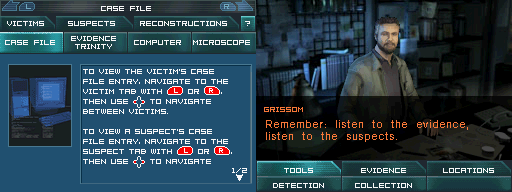
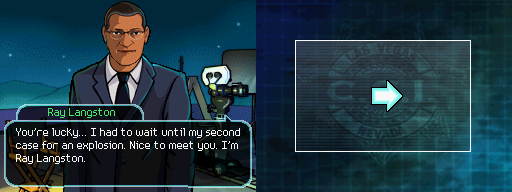
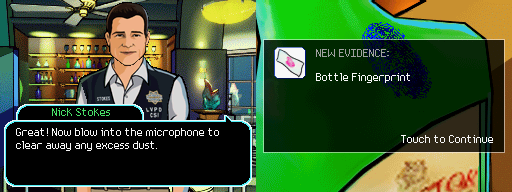
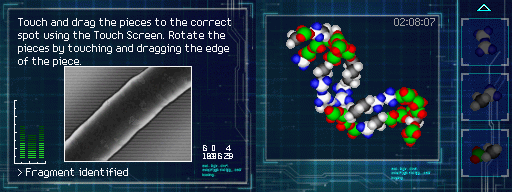
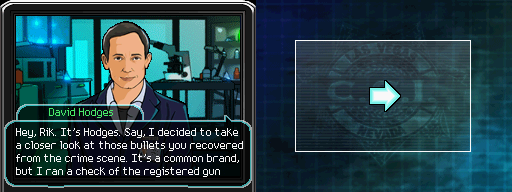
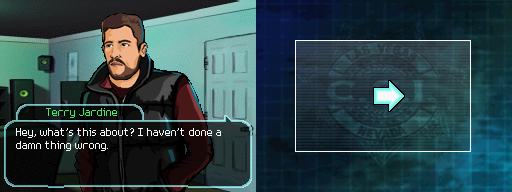
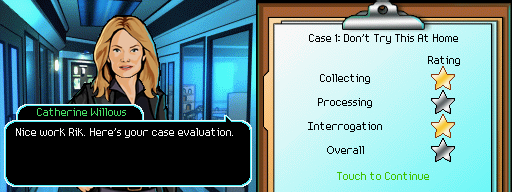


 Posts
Posts